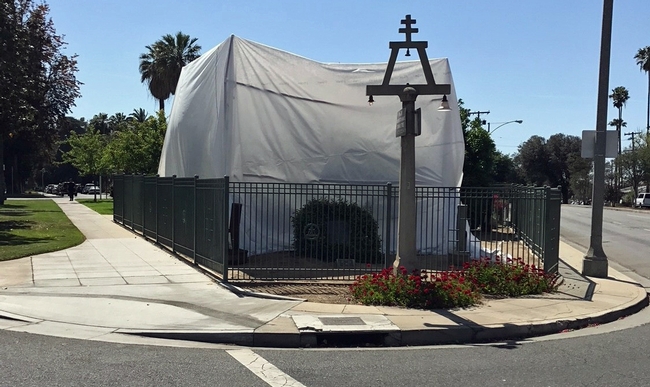
Posts Tagged: Georgios Vidalakis
City of Riverside tents iconic tree to protect it from huanglongbing disease
The city of Riverside pitched a white tent over the "Parent Navel" orange tree at the intersection of Arlington and Magnolia avenues last week to protect it from the threat of huanglongbing disease, reported Ryan Hagen the Riverside Press Enterprise.
“The Parent Navel is an iconic symbol of Riverside, as it represents the impact the citrus industry had on our economy,” Mayor Rusty Bailey said in a press release issued by the City of Riverside. “Riversiders hold this symbol of our citrus heritage very dear, so it is encouraging to see our parks personnel taking a proactive approach.”
The tree was one of two planted by Eliza Tibbets in 1873, when she received the seedless orange cultivars from Florida by mail. Tibbets cared for the trees and sold budwood to nurseries, which led to extensive plantings of nursery trees cloned from hers.
Huanglongbing disease made its appearance in Riverside last year in residential trees. Officials are working to prevent its spread by controlling Asian citrus psyllid, the insect that can move the disease from tree to tree. Meanwhile researchers are searching for a cure.
The Parent Navel's high value led UC Riverside researchers and city officials to construct the large white barrier.
"It's not beautiful," said Georgios Vidalakis, UC Cooperative Extension specialist and director of the citrus clonal protection program at UC Riverside. "It's obstructing the tree from public view, and we apologize for that. But the risk from not doing that is catastrophic."
143-year-old Washington navel mother tree gets special care

"We're not going to let this tree die," said Georgios Vidalakis, UC Cooperative Extension specialist in the Department of Plant Pathology at UC Riverside. Vidalakis is the director of the UC Citrus Clonal Protection Program.
Scientists protect the tree using special tools, insecticides and disease monitoring.
According to legend, the seedless and sweet Washington navel was an accidental mutant that appeared on the grounds of a Brazil monastery in the early 1800s. Tree clones were sent to USDA in Washington, D.C., and from there acquired by Eliza Tibbets, who tended the trees at her home in Riverside.
"Producing budding stock to make other saplings, Tibbets' trees birthed a citrus industry dubbed California's second gold rush," the Press-Enterprise story said.
John Bash, a UC Riverside staff researcher who worked with the Washington navel for 32 years, called the mother tree "one of the world's agricultural icons."
"There are literally millions and millions of trees that can trace their ancestry back to that single tree," Bash said.
